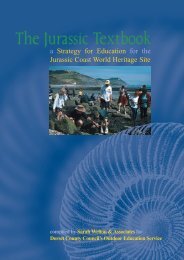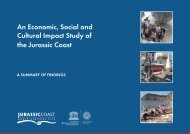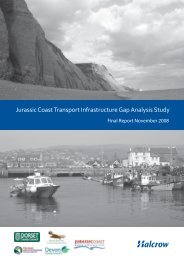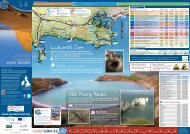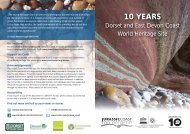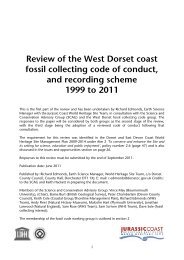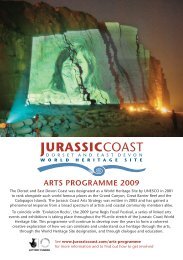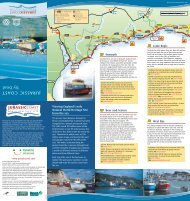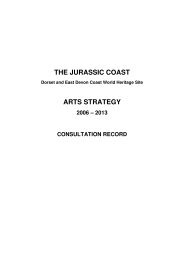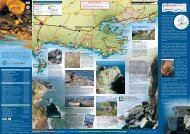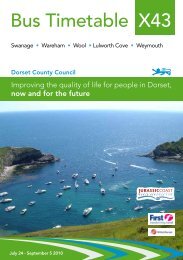Final Report to DEFRA - Jurassic Coast
Final Report to DEFRA - Jurassic Coast
Final Report to DEFRA - Jurassic Coast
Create successful ePaper yourself
Turn your PDF publications into a flip-book with our unique Google optimized e-Paper software.
The method used was a telephone survey of adults living in the six case study areas –<br />
Charmouth, Pres<strong>to</strong>n, Ringstead, Sea<strong>to</strong>wn, Sidmouth and Swanage. The summary<br />
reports of both waves are included at Appendix 3.<br />
While the first wave survey produced some very useful and revealing baseline<br />
information which helped establish our starting point (see section 3.2), the second survey<br />
revealed a disappointing lack of statistically significant change in awareness of and<br />
opinions about coastal change in the wider communities surveyed. This may be<br />
explained by:<br />
• The conscious decision by the project team <strong>to</strong> focus on those with most at stake,<br />
and <strong>to</strong> do so via direct contact rather than indirectly via the local media. This<br />
allowed us <strong>to</strong> manage the process of engagement without the risk of the agenda<br />
being set by others, but in doing so perhaps restricted the ‘reach’ of the project<br />
message beyond those most affected by coastal change.<br />
• The fact that the large size of some of the sample areas (e.g. Swanage and<br />
Sidmouth) inevitably included many people who are not directly affected by<br />
coastal change, or would not perceive themselves <strong>to</strong> be. For further discussion of<br />
this, see section 4.1 on ‘Engaging stakeholders in coastal change who don’t think<br />
they have a stake’.<br />
The number of people who attended the public exhibitions (who gave very positive<br />
feedback) was similar <strong>to</strong> the number surveyed so we can perhaps conclude that the<br />
project had a positive impact on those with whom it was able <strong>to</strong> directly engage, but not<br />
on those who were only exposed <strong>to</strong> it indirectly. While it might have been possible <strong>to</strong><br />
reach a wider audience via a more high profile project, this may have required an<br />
unacceptable trade-off with both the quality of the contact we enjoyed with those who did<br />
participate in the project, and our ability <strong>to</strong> manage the engagement process without the<br />
risk of the issues being misinterpreted, misrepresented or sensationalised.<br />
23



